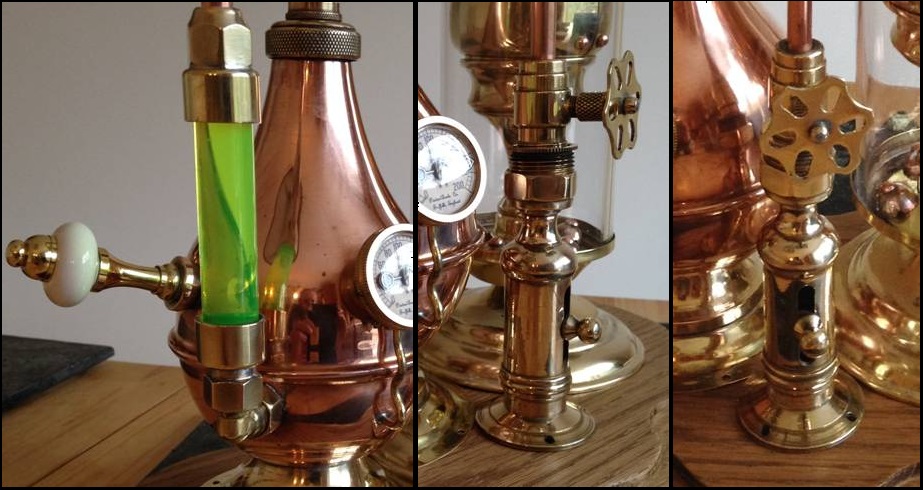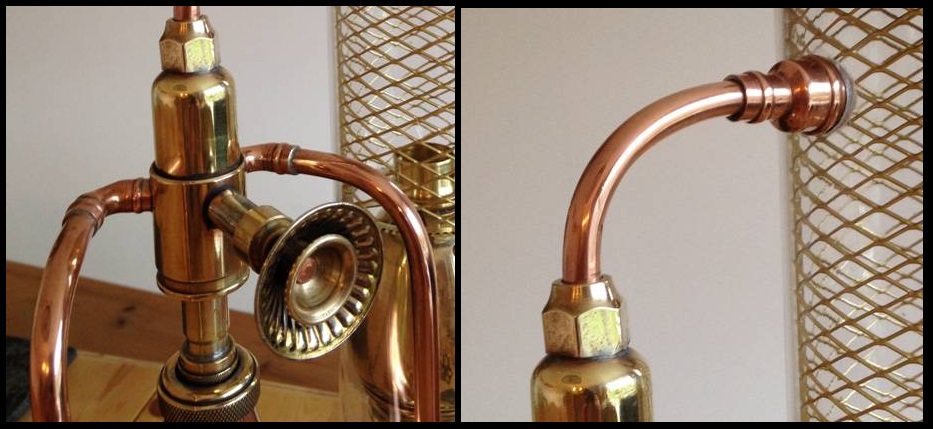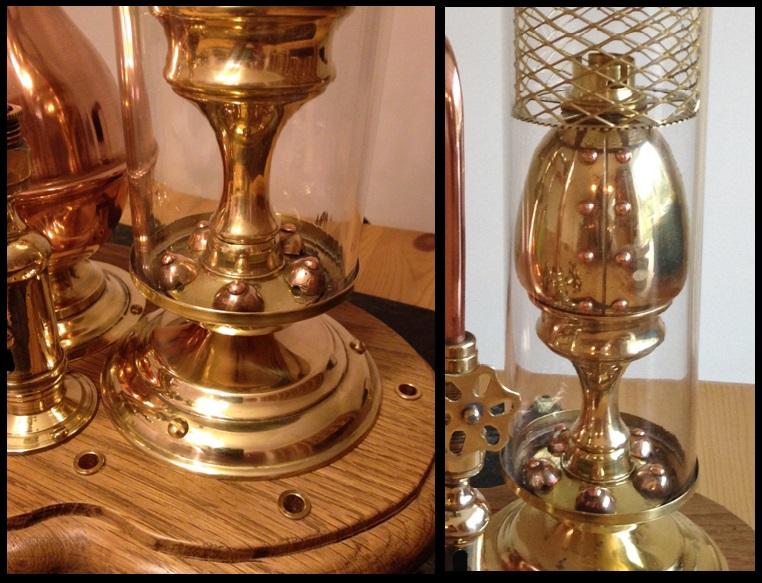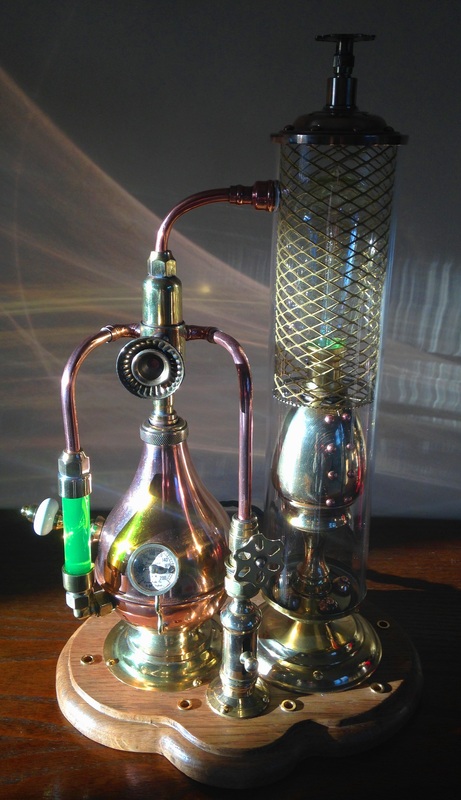This desk lamp build utilises many salvaged and re-purposed components from various objects such as a copper jug, candle stick and lamp parts, plumbing components as well as some custom made parts. The Boiler Section.
This started its life as an ornamental copper jug which I de-constructed to remove the handle, pouring spout and copper base. I replaced the base with a two-part brass base, wider at the foot than the original and with a flat flange to allow it to be fixed to the wooden base. The small pressure gauge is made from the cup section of a light bulb holder. The dial is made by cutting a thin disc of 28mm diameter dowel and one of my printed adhesive dial plates. The pointer is a shop-bought one from a card-craft supplier. This is held in place by a small brass rivet. The glass dome is a watch crystal held in place by the screw-threaded lampshade ring. This, and the small brass pipe had to be soldered into place before adding the internals.
This started its life as an ornamental copper jug which I de-constructed to remove the handle, pouring spout and copper base. I replaced the base with a two-part brass base, wider at the foot than the original and with a flat flange to allow it to be fixed to the wooden base. The small pressure gauge is made from the cup section of a light bulb holder. The dial is made by cutting a thin disc of 28mm diameter dowel and one of my printed adhesive dial plates. The pointer is a shop-bought one from a card-craft supplier. This is held in place by a small brass rivet. The glass dome is a watch crystal held in place by the screw-threaded lampshade ring. This, and the small brass pipe had to be soldered into place before adding the internals.
The glass sight gauge uses an 8mm brass elbow fitting at the bottom, soldered into a 16mm hole drilled into the side of the copper body. The glass phial is filled with a water-based luminescent coolant. This is capped at the top and bottom by plastic-lined brass dimmer switch covers. A second 8mm cone nut is used as a guide for the copper pipe leading to the three-way brass fitting on top of the boiler. The brass and ceramic ‘tap’ on the side of the boiler is made using a light-pull and a 15mm brass end cap. The wheel valve section is made from an inverted portion of a candlestick (with ejector) and an in-line valve from an old Tilley lamp. The wheel itself I fashioned from 1.5mm brass sheet.
The three-way brass top section of the boiler is taken from an old Tilley lamp. Two of the original steel tubes have been replaced with 8mm copper elbow joints to accept the copper pipes. A double brass flared ‘horn’ was fixed to the third tube. This was made from riveting together the mouthpiece of an old post horn and the horn from a small gramophone ornament. Another 8mm brass cone nut is soldered to the top to accept the copper pipe connecting it to the lamp section.
The Lamp Section.
The base of the lamp is made from two parts of an old brass candlestick lamp and a 70mm diameter brass cup from an old chandelier. I cut out five bronze discs and hammered them into cup shapes using a doming block and then riveted these to one of the candlestick bases for decoration. The acrylic tube is 70mm diameter and slots very nicely into the brass cup from the chandelier.
The base of the lamp is made from two parts of an old brass candlestick lamp and a 70mm diameter brass cup from an old chandelier. I cut out five bronze discs and hammered them into cup shapes using a doming block and then riveted these to one of the candlestick bases for decoration. The acrylic tube is 70mm diameter and slots very nicely into the brass cup from the chandelier.
The upper ‘bulb’ section is made from the two-part cast brass lamp stand. I had to drill out a 28mm diameter hole to receive the light bulb holder and I also cut a false seam and added some copper rivets. The light bulb holder is fitted with a large gear from a clock which splits the light tube in two at the half-way point. A section of pressed brass mesh was added inside the top half of the acrylic tube to alleviate some of the heat from the light bulb. This also adds a very interesting pattern to any lit surfaces. This section is then capped-off with another cast brass candlestick base into which I drilled holes for heat escape and added a working air lock valve topped with a re-shaped Mecanno wheel and added decorative copper rivets.
All three sections are then mounted on to a solid oak base cut to fit the shape of the three parts. This was stained and waxed to give the wood a medium ‘Georgian oak’ colour. Brass inserts were also added for decoration. Even in daylight it really makes an impact with reflected and diffused light.








 RSS Feed
RSS Feed
